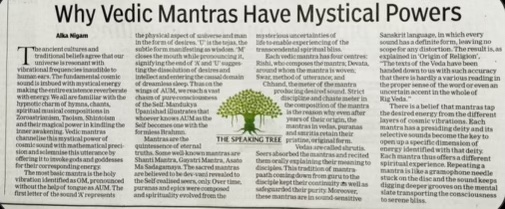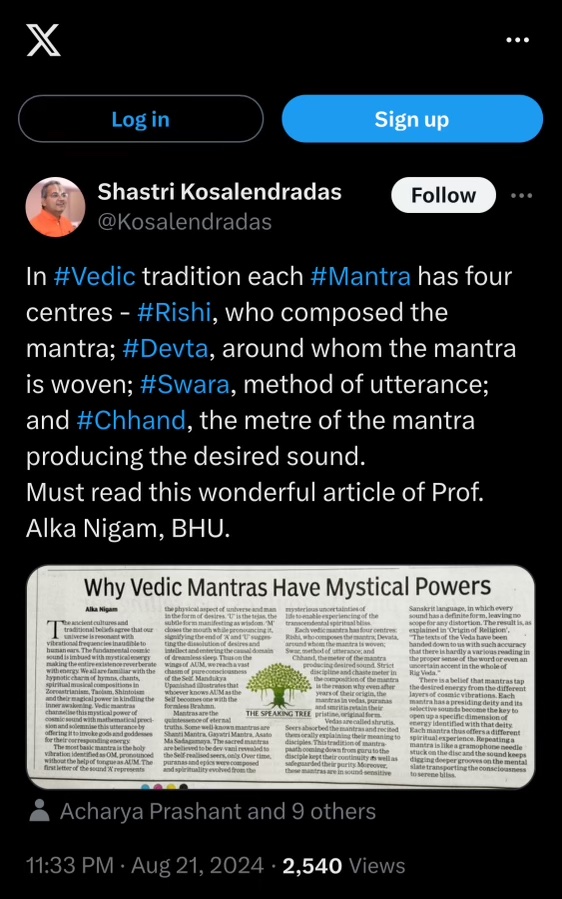Published: 22nd August, 2024; The Speaking Tree, The Times of India

The ancient cultures and traditional beliefs agree that our universe is resonant with vibrational frequencies inaudible by human ears. Modern science has discovered that this deep sound in the space is coming from the sun. NASA has recorded this vibration in the universal language system for the human ears and mentioned that this is precisely the sound that is mentioned in the Vedas as AUM. The fundamental cosmic sound is imbued with mystical energy making the entire existence reverberate with energy. Certain sounds of our planet when tuned with this cosmic frequency create an ambience filled with a divine energy that uplifts the consciousness leaving tremendous impact on the physiological and psychological frameworks. We all are familiar with the hypnotic charm of hymns, chants, spiritual musical compositions in Zoroastrianism, Taoism, Shintoism and their magical power in kindling the inner awakening. Vedic Mantras channelize this mystical power of cosmic sound with mathematical precision and solemnize this utterance by offering it to invoke gods and goddesses for their corresponding energy.
The most basic mantra is the holy vibration identified as OM pronounced without the help of tongue as AUM. The first letter of the sound A as the source o represents the physical aspect of universe and man in the form of desires. U is the Taijas, the subtle form manifesting in wisdom. M closes the mouth meaning the end of A and U and therefore the dissolution of desires and intellect and entering in the causal domain of dreamless sleep. Thus on the wings of OM we reach a vast chasm of pure consciousness of SELF. Mandukya Upanishad illustrates that whoever knows OM as the Self becomes one with the formless Brahma. Om is a complete mantra all by itself and many a times as the basic mantra added as prefix or suffix with other mantras.
Mantras are the quintessence of eternal truths. Some well –known Mantras are SHANTI Mantra appearing in the Taittiriya Upanishad, GAYATRI Mantra Book 3 of Rig Veda, ASATO MA SADAGAMAYA in Brihadaranayak Upanishad. The four Vedas existed even before the birth of the universe. How can that be related with the sages? Interestingly the sages humbly take the credit as not the creators but only as MANTRADRISHTA saying that the mantras were revealed to them in their high state of divine consciousness. The sacred mantras are thus DEV-VANI and come to the self -realized seers only, like one of the saptrishis- Angira – associated with Atharva Veda, and Bharadwaj who said to have contributed to the hymns of Rig Veda. Sage Vishwamitra’s spiritual journey from King to Devarishi to Brahmarishi illustrates that only when the last trace of ego has left that the seer is worthy of being illuminated by the light of GAYATRI Mantra. Over time Puranas and Epics were composed and spirituality evolved from the mysterious uncertainties of life to experiencing transcendental spiritual bliss.
Each Vedic Mantra has four centers: Rishi, who composes the mantra, Devata, around whom the mantra is woven, Swar, method of utterance and Chand, meter of the mantra producing desired sound. Strict discipline and chaste meter in the composition of the mantra is the reason why even after crores of years of their origin, the mantras in Vedas, Puranas and Smritis could retain their pristine, original form. Vedas are called Shrutis. Seers absorbed the mantras and recited them orally explaining their meaning to disciples. This tradition of mantra-paath coming down from one Guru to another for ages, kept their continuity as well as safeguarded their purity. Moreover, these mantras are in sound-sensitive Sanskrit language in which every sound has a definite form, leaving no scope of any distortion. The result is, as explained in Origin of Religion, “the texts of the Veda have been handed down to us with such accuracy that there is hardly a various reading in the proper sense of the word or even an uncertain accent in the whole of Rigveda.”
One of the most arresting factors of the mantras is that they tap the desired energy from the different layers of cosmic vibrations. Each Mantra has a presiding deity. Each mantra with its selective sounds becomes the key to open up a specific dimension of energy identified with that deity. Each mantra thus offers a different spiritual experience. Repeating a mantra again and again is like a gramophone needle stuck on the disc and the sound keep digging deeper grooves on the mental slate transporting the consciousness to serene bliss.

Leave a Reply